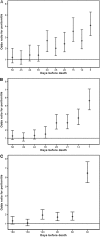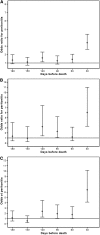Recent peritonitis associates with mortality among patients treated with peritoneal dialysis
- PMID: 22626818
- PMCID: PMC3402287
- DOI: 10.1681/ASN.2011121135
Recent peritonitis associates with mortality among patients treated with peritoneal dialysis
Abstract
Peritonitis is a major complication of peritoneal dialysis, but the relationship between peritonitis and mortality among these patients is not well understood. In this case-crossover study, we included the 1316 patients who received peritoneal dialysis in Australia and New Zealand from May 2004 through December 2009 and either died on peritoneal dialysis or within 30 days of transfer to hemodialysis. Each patient served as his or her own control. The mean age was 70 years, and the mean time receiving peritoneal dialysis was 3 years. In total, there were 1446 reported episodes of peritonitis with 27% of patients having ≥ 2 episodes. Compared with the rest of the year, there were significantly increased odds of peritonitis during the 120 days before death, although the magnitude of this association was much greater during the 30 days before death. Compared with a 30-day window 6 months before death, the odds for peritonitis was six-fold higher during the 30 days immediately before death (odds ratio, 6.2; 95% confidence interval, 4.4-8.7). In conclusion, peritonitis significantly associates with mortality in peritoneal dialysis patients. The increased odds extend up to 120 days after an episode of peritonitis but the magnitude is greater during the initial 30 days.
Figures




References
-
- Excell L, Livingston B, McDonald SP: ANZDATA Registry Report 2010, Adelaide, South Australia, Australia and New Zealand Dialysis and Transplant Registry, 2010
-
- Fang W, Qian J, Lin A, Rowaie F, Ni Z, Yao Q, Bargman JM, Oreopoulos DG: Comparison of peritoneal dialysis practice patterns and outcomes between a Canadian and a Chinese centre. Nephrol Dial Transplant 23: 4021–4028, 2008 - PubMed
-
- Hiramatsu M, Japanese Society for Elderly Patients on Peritoneal Dialysis : How to improve survival in geriatric peritoneal dialysis patients. Perit Dial Int 27[Suppl 2]: S185–S189, 2007 - PubMed
-
- Sipahioglu MH, Aybal A, Unal A, Tokgoz B, Oymak O, Utas C: Patient and technique survival and factors affecting mortality on peritoneal dialysis in Turkey: 12 years’ experience in a single center. Perit Dial Int 28: 238–245, 2008 - PubMed
-
- Abraham G, Kumar V, Nayak KS, Ravichandran R, Srinivasan G, Krishnamurthy M, Prasath AK, Kumar S, Thiagarajan T, Mathew M, Lesley N: Predictors of long-term survival on peritoneal dialysis in South India: A multicenter study. Perit Dial Int 30: 29–34, 2010 - PubMed
MeSH terms
LinkOut - more resources
Full Text Sources
Medical

